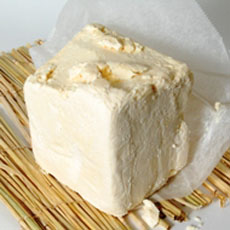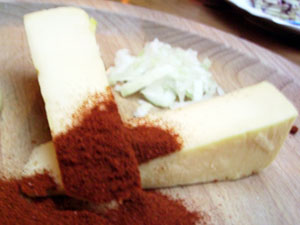
 You can buy Weisslacker cheese at MurraysCheese.com You can buy Weisslacker cheese at MurraysCheese.com
March 2009
|
 |
Weisslacker
For Those Who Love A Good Stinky Cheese
CAPSULE REPORT: Like stinky cheese and a good beer? We’ve got a cheese for you: the highly odiferous Weisslacker, or Beer Cheese, originally from Germany. BYOB.
Overview
Related to Limburger, Weisslacker originated in Germany; in America it is produced mostly in Wisconsin. Also called beer cheese (or in German, bierkäse, bierkaese, beer kaese) it is a pungent, salted rind, soft ripened cheese made of cow’s milk. The name literally means “white varnish” in German because of the cheese’s white, smeary, lustrous surface that comes from the white mold that develops on it. Fans of Weisslacker often enjoy it with beer (sometimes dipping the cheese directly in the beer), hence the name; it is too overpowering to serve with most wines. It is a common item on pub and restaurant menus in the Czech Republic, the country with the highest per-capita beer consumption in the world.
To quote Murray’s Cheese, “The smell of Weisslacker gives you the impression that it’s almost alive and you want to beat it back with a stick.” Intense aromas fill the room. As with Epoisses and other stinkers, this is either your thing or not. If it is, you want another bite, and then another of this crumbly-paste seductress.
How Weisslacker Is Made
The milk from European Weisslacker comes from cows that graze high in the Alps, at least 2,600 feet above sea level. After the curds are molded, the cheese spends two days in a salt bath and six weeks aging in a warm room where it is smeared twice weekly with salt. It is aged for another nine months in highly humid conditions.
Weisslacker was born in 1874, during the Franco-Prussian War. There was a need to make cheese provisions that could keep for extended travels. Many of the cheesemakers traditionally made softer washed rind cheeses that would soon break down. Brothers Anton and Josef Kramer of Wertach, Germany adjusted the recipe for Backsteinkäse (brick cheese), increasing the salt and fat content and lengthening the aging time. The cheese is made in a brick, 4 to 5 inches square and 3-1/2 inches or more thick. A typical cheese weighs from 2-2/3 to 3-1/3 pounds.
Weisslacker was a hit and the brothers received a 15-year royal patent on the recipe.
Serving Weisslacker
In Germany and Czechoslovakia, Weisslacker is popularly served on small slices of rye  or pumpernickel bread with mustard, often with some sliced raw onion. Weisslacker is also an ingredient in breads, dips and soups. In Bavaria, the cheese is grated over spaetzle. or pumpernickel bread with mustard, often with some sliced raw onion. Weisslacker is also an ingredient in breads, dips and soups. In Bavaria, the cheese is grated over spaetzle.
Weisslacker with raw onion and lots of paprika. Photo courtesy of Wikipedia Commons.
Contemporary serving ideas:
- Top sweet buttered dark bread with the cheese, sliced radishes and a crack of fresh-ground pepper
- Serve with hearty sausages and a Vidalia onion and cucumber salad
- Garnishes: pepper, caraway, finely chopped herbs
And don’t forget the beer!
Buy Weisslacker Cheese Online
If you can’t find Weisslacker locally, you can buy it at MurraysCheese.com, for $11.99 per half pound.
Lifestyle Direct, Inc. All rights reserved. Images are the copyright of their respective owners.

|




 You can buy Weisslacker cheese at MurraysCheese.com
You can buy Weisslacker cheese at MurraysCheese.com or pumpernickel bread with mustard, often with some sliced raw onion. Weisslacker is also an ingredient in breads, dips and soups. In Bavaria, the cheese is grated over spaetzle.
or pumpernickel bread with mustard, often with some sliced raw onion. Weisslacker is also an ingredient in breads, dips and soups. In Bavaria, the cheese is grated over spaetzle.